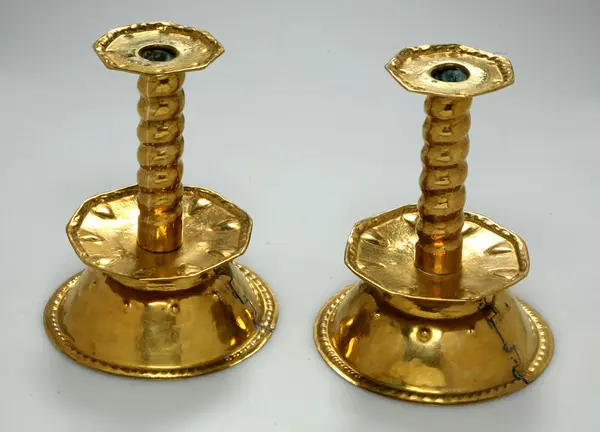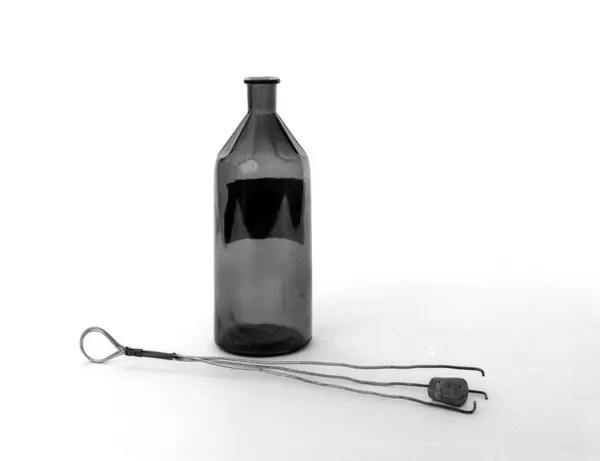The objects were often beautifully engraved and were magnificently decorated. Platters and candlesticks were often made of brass. The craftsmanship was often of high quality; the items were exquisitely decorated and were used as gifts for important events such as baptisms and weddings.
In the Haugesund area, just after the war, Nannastakene (the "Nanna" candlesticks) were popular wedding gifts among the residents. The candlesticks, made by Tater people who settled there, can still be found in many homes in Haugesund and the surrounding area (Paulsen 2006).
- 1/1
Two «Nanna» candlesticks in brass. Copies of baroque altar candlesticks from the 18th century. Made by Oliver Larsen, 1930 in Haugesund. Foto: Anno Glomdalsmuseet
- 1/2
Details on coffee pot, Aksel and Hulda Karlsen’s wedding gift made in nickel silver, 1920. Foto: Emir Curt/Anno Glomdalsmuseet - 2/2
Aksel and Hulda Karlsen’s wedding gifts made in nickel silver: coffee grinder, 1920. Foto: Emir Curt/Anno Glomdalsmuseet
- 1/3
Drinking horn with embellished details in nickel silver. Made by Nils Karl Magnus Karlsen. Foto: Anno Glomdalsmuseet - 2/3
Details og engraving on drinking horn. Foto: Anno Glomdalsmuseet - 3/3
Details og engraving on drinking horn. Foto: Anno Glomdalsmuseet
- 1/1
Copper coffee pot with beautiful engraving. Made during the interwar years. Nickel silver on the lid and handle. Foto: Anno Glomdalsmuseet
Jewellery, pins and brooches
The Tater people would purchase jewellery from the jeweller, but they also made jewellery such as pins, brooches and filigree brooches from silver or nickel silver. They often wore silver combs and earrings or gold earrings. The women wore large filigree brooches and wide gold bands that they received when they got engaged, which were called "solder rings". The men wore the "pledge ring"; some Travellers made them for themselves.
- 1/3
Filigree brooch by Johan Julius Johansen. Foto: Anno Glomdalsmuseet - 2/3
Wedding rings, man's pledge ring and woman's solder ring, and ear ornaments in gold. Foto: Anno Glomdalsmuseet - 3/3
Marie Lovinie Oliversens' hair comb. Foto: Anno Glomdalsmuseet
- 1/1
Personal jewelry: comb, filigree brooch and belt buckle. Foto: Anno Glomdalsmuseet
Wire crafts
Different groups have made their living by producing objects from steel wire, and it is difficult to distinguish the Tater people’s products from those of other craftsmen. In Norway, though, wire work is associated with the Tater people, whereas in Sweden vagabonds and prison inmates were also producers of wire crafts.
Many Tater people in Norway associate wire crafts with low status and poverty. Wire craft was what you resorted to when there were no other opportunities. The material was easily accessible. It could be cut from the farmer's steel wire fence in the morning and sold back to the same farmer in the afternoon as whisks, platters, graters, or other products. The product design was very creative. Countless versions of whisks, platters, baskets, egg cups, clothes hangers, graters, corkscrews, shelves - and of many other items - were produced.
Despite the fact that many have an ambivalent attitude towards wire work, there is now some pride in this. Today, Tater people make earrings inspired by older wire crafts. During school displays and events in which Tater people exhibit their culture, wire crafts are presented as a central and positive part of their traditional crafts.
- 1/5
Wire craft, colourful serving dish. Foto: Anno Glomdalsmuseet - 2/5
Wire craft, berry picker. Foto: Anno glomdalsmuseet - 3/5
Wire craft, corkscrew. Used when the cork fell into the bottle. Foto: Anno Glomdalsmuseet - 4/5
Whisks from wire craft. Foto: Anno Glomdalsmuseet - 5/5
Wire crafted grate for flatiron. Foto: Anno Glomdalsmuseet
- 1/5
Clock stand made by Glenn Frode Pedersen. Foto: Anno Glomdalsmuseet - 2/5
Mariann Grønnerud wire crafting at the Grundset marked in 2012. Foto: Anno Glomdalsmuseet - 3/5
Bottle rack made by wire craft. Foto: Anno Glomdalsmuseet - 4/5
Glenn Frode Pedersen making and selling wire craft items at the Glomdal Museum, 2013. Foto: Anno Glomdalsmuseet - 5/5
Wirecrafted, egg holder for boiling eggs. Foto: Anno Glomdalsmuseet
- 1/1

























